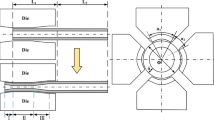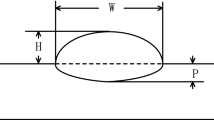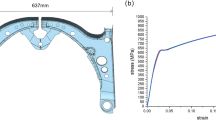Abstract
To control the precision forging product forming quality, a multi-objective optimization method for process parameters design was proposed by applying Latin hypercube design method and response surface model approach. Meanwhile, the deformation homogeneity and material damage of forging product was first presented for evaluating the forming quality. Then, as a case of study, the radial precision forging for a hollow shaft with variable cross section and wall thickness was carried out. The 3D rigid-plastic finite element (FE) model of the radial precision forging was established. The parameters on the forming quality evaluation function study were discussed to investigate the multi-objective optimization model. Non-dominated sorting genetic algorithm-II (NSGA-II) was adopted to obtain the Pareto-optimal solutions. A compromise solution was selected from the Pareto solutions by using the mapping method. Experiments with the same parameter settings were compared with the simulations. After conducting radial forging and mechanical property experimental study on the forging product by multi-objective optimization process parameters, the feasibility of the multi-objective optimization method for the precision forging product forming quality was verified.
Similar content being viewed by others
References
Yilmaz NF, Eyercioglu O (2009) An integrated computer-aided decision support system for die stresses and dimensional accuracy of precision forging dies. Int J Adv Manuf Technol 40(9–10):875–886
Chen J, Chandrashekhara K, Mahimkar C, Lekakh SN, Richards VL (2012) Study of void closure in hot radial forging process using 3D nonlinear finite element analysis. Int J Adv Manuf Technol 62(9–12):1001–1011
Zhao GQ, Ma XW, Zhao XH, Grandhi RV (2004) Studies on optimization of metal forming processes using sensitivity analysis methods. J Mater Process Technol 147(2):217–228
Zhao XH, Zhao GQ, Wang GC, Wang TH (2002) Preform die shape design for uniformity of deformation in forging based on preform sensitivity analysis. J Mater Process Technol 128(1–3):273–278
Acharjee S, Zabaras N (2006) The continuum sensitivity method for the computational design of three-dimensional deformation processes. Comput Methods Appl Mech Eng 195(48–49):6822–6842
Wu YJ, Dong XH, Yu Q (2014) An upper bound solution of axial metal flow in cold radial forging process of rods. Int J Mech Sci 85:120–129
Wu YJ, Dong XH, Yu Q (2015) Upper bound analysis of axial metal flow inhomogeneity in radial forging process. Int J Mech Sci 93:102–110
Ghaei A, Taheri AK, Movahhedya MR (2006) A new upper bound solution for analysis of the radial forging process. Int J Mech Sci 48:1264–1272
Sanjari M, Taheri AK, Ghaei A (2007) Prediction of neutral plane and effects of the process parameters in radial forging using an upper bound solution. J Mater Process Technol 186(1–3):147–153
Sanjari M, Taheri AK, Movahedi MR (2009) An optimization method for radial forging process using ANN and Taguchi method. Int J Adv Manuf Technol 40(7–8):776–784
Yang YH, Liu D, He ZY, Luo ZJ (2010) Optimization of preform shapes by RSM and FEM to improve deformation homogeneity in aerospace forgings. Chin J Aeronaut 23(2):260–267
Tang YC, Zhou XH, Chen J (2008) Preform tool shape optimization and redesign based on neural network response surface methodology. Finite Elem Anal Des 44(8):462–471
Wang H, Li GY, Zhong ZH (2008) Optimization of sheet metal forming processes by adaptive response surface based on intelligent sampling method. J Mater Process Technol 197(1–3):77–88
Oudjene M, Ayed LB, Delameziere A, Batoz JL (2009) Shape optimization of clinching tools using the response surface methodology with moving least-square approximation. J Mater Process Technol 209(1):289–296
Lee SK, Jeong MS, Kim BM, Lee SK, Lee SB (2013) Die shape design of tube drawing process using FE analysis and optimization method. Int J Adv Manuf Technol 66(1–4):381–392
Zhou J, Lin L, Luo Y (2014) The multi-objective optimization design of a new closed extrusion forging technology for a steering knuckle with long rod and fork. Int J Adv Manuf Technol 72(9–12):1219–1225
Zhou G, Ma ZD, Cheng AG, Li GY, Huang J (2015) Design optimization of a run-flat structure based on multi-objective genetic algorithm. Struct Multidiscip Optim 51(6):1363–1371
Liu SH (2015) Multi-objective optimization design method for the machine tool’s structural parts based on computer-aided engineering. Int J Adv Manuf Technol 78(5–8):1053–1065
Zhang GJ, Zhang Z, Ming WY, Guo JW, Huang Y, Shao XY (2014) The multi-objective optimization of medium-speed WEDM process parameters for machining SKD11 steel by the hybrid method of RSM and NSGA-II. Int J Adv Manuf Technol 70(9–12):2097–2109
Ai M, Li K, Liu SM, Lin DKJ (2013) Balanced incomplete Latin square designs. J Stat Plan Infer 143(9):1575–1582
He XM (2011) Effects of manipulator compliant movements on the quality of free forgings based on FEM simulation. Int J Adv Manuf Technol 56(9–12):905–913
Ceretti E, Lucchi M, Altan T (1999) FEM simulation of orthogonal cutting: serrated chip formation. J Mater Process Technol 95(1–3):17–26
Acherjee B, Kuar AS, Mitra S, Misra D (2013) A sequentially integrated multi-criteria optimization approach applied to laser transmission weld quality enhancement—a case study. Int J Adv Manuf Technol 65(5–8):641–650
Saklakoglu IE, Kasman S (2011) Investigation of micro-milling process parameters for surface roughness and milling depth. Int J Adv Manuf Technol 54(5–8):567–578
Author information
Authors and Affiliations
Corresponding author
Rights and permissions
About this article
Cite this article
Zhu, F., Wang, Z. & Lv, M. Multi-objective optimization method of precision forging process parameters to control the forming quality. Int J Adv Manuf Technol 83, 1763–1771 (2016). https://doi.org/10.1007/s00170-015-7682-1
Received:
Accepted:
Published:
Issue Date:
DOI: https://doi.org/10.1007/s00170-015-7682-1




